

Visualizing the importance of retention in Freemium. A freemium product's retention curve is generally accepted to assume the shape of a negative exponential function, as below: A retention curve might take this form if retention in the earliest stages of product use was determined solely by quality, but it is not.
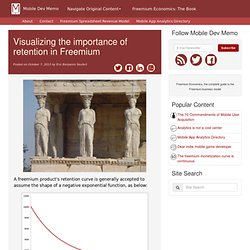
Rather, early retention -- especially Day 1 retention -- is affected by a number of other factors, mostly related to marketing. Marketing channel mix can impact early stage retention substantially. Low conversion in free-to-play is a feature, not a bug. An article excoriating the supposed plague that is free-to-play made the rounds recently, citing engagement statistics from Swrve's April report in support of an argument asserting that, because average engagement rates for free-to-play games are low, and the percentage of players that pay anything within free-to-play games is very low, consumers clearly don’t enjoy free-to-play games.
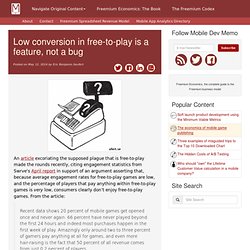
From the article: Recent data shows 20 percent of mobile games get opened once and never again. 66 percent have never played beyond the first 24 hours and indeed most purchases happen in the first week of play. Amazingly only around two to three percent of gamers pay anything at all for games, and even more hair-raising is the fact that 50 percent of all revenue comes from just 0.2 percent of players.This is a statistically insignificant amount of happy gamers and nothing that gives you a basis to make claims about “what people want”.
The Freemium Codex - A collection of freemium resources. Evernote By The Numbers: 34M Users, 1.4M Paying, And The Relative Merits Of Different Platforms. Phil Libin, the CEO of note taking app Evernote, is sitting on a $1 billion valuation and plans for an IPO, and while it may be a while yet before it follows through on going public , today at LeWeb in London he revealed new numbers for just how much the service is getting used, and how much money different platforms are bringing into the pot.

He said that the company now has 34 million users overall across all platforms — mobile and web — with the number of paying users now at 1.4 million: that’s a significant rise on the 25 million overall and 1 million paying users Evernote last reported as recently as May, when it announced its $70 million round. He then did something a little atypical for a startup,which can be cagey about how much money it makes when the chief aim is to scale as much as possible. He talked about average revenues per user, on an annual basis, based on different platforms. It goes like this: DESKTOP Desktop web $1.81 Windows PC $2.33Mac OS $3.16. Google Wallet Is Leaking Money. Google Wallet (GOOG), the mobile software that allows Android users to pay for purchases online and in stores with their phones, has become a money pit.
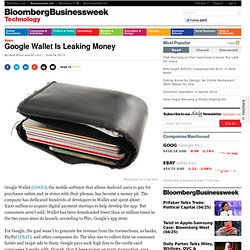
The company has dedicated hundreds of developers to Wallet and spent about $300 million to acquire digital payment startups to help develop the app. But consumers aren’t sold. Wallet has been downloaded fewer than 10 million times in the two years since its launch, according to Play, Google’s app store. For Google, the goal wasn’t to generate fee revenue from the transactions, as banks, PayPal (EBAY), and other companies do.
The idea was to collect data on consumer habits and target ads to them. Fred Wilson is wrong about “Free” by Dalton Caldwell. Fred Wilson is one the smartest, most genuine people in the tech business.
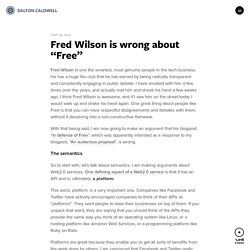
He has a huge fan club that he has earned by being radically transparent and consistently engaging in public debate. I have emailed with him a few times over the years, and actually met him and shook his hand a few weeks ago. I think Fred Wilson is awesome, and if I saw him on the street today I would walk up and shake his hand again.
If Freemium Is In, Then Why Do Paid Apps Still Reign Supreme? Earlier today, we posted on some data from Pando Networks that shows that free-to-play online games, often overlooked in the hype around social and casual games, are growing just as fast and as furiously around the globe as their counterparts.

Obviously, much of this has to do with the industry’s transition from paid to freemium models — the examples of which are numerous not only in online gaming, but for web and mobile apps on the whole — and even startups and SMBs making their way in the consumer Web. Case Studies in Freemium: Pandora, Dropbox, Evernote, Automattic. In-App Purchases Will Dominate the Smartphone App Business - Media Market Research at iSuppli.
What’s the best way to make money in the smartphone apps market?
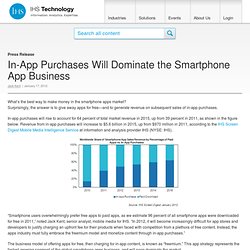
Surprisingly, the answer is to give away apps for free—and to generate revenue on subsequent sales of in-app purchases. In-app purchases will rise to account for 64 percent of total market revenue in 2015, up from 39 percent in 2011, as shown in the figure below. Revenue from in-app purchases will increase to $5.6 billion in 2015, up from $970 million in 2011, according to the IHS Screen Digest Mobile Media Intelligence Service at information and analysis provider IHS (NYSE: IHS). Freemium is better than Free « Alexander van Elsas’s Weblog on n. A few interesting posts drew my attention this morning.
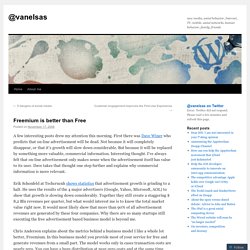
First there was Dave Winer who predicts that on-line advertisement will be dead. Not because it will completely disappear, or that it’s growth will slow down considerable. But because it will be replaced by something more valuable, commercial information. Interesting thought. I’ve always felt that on-line advertisement only makes sense when the advertisement itself has value to its user. Apple cult mocked by Samsung in Galaxy S II ad. "I could never get a Samsung," says a self-consciously cool-looking, whiny dude, seated on the sidewalk.

"I'm creative. " "You're a barista," says the man standing next to him in line. The Complete Guide To Freemium Business Models. Editor’s note: This guest post was written by Uzi Shmilovici, CEO and founder of Future Simple, which creates online software for small businesses.

The post is based on a study done with Professor Eric Budish, an economics professor at the University of Chicago Booth School of Business. It also includes ideas and comments from Peter Levine, a Venture Partner at Andreessen-Horowitz and a professor at Stanford GSB The idea of offering your product or a version of it for free has been a source of much debate. Ever-Growing Evernote Hits 10 Million Users (425,000 Paying Ones, Too)
May 2009: Evernote hits 1 million registered users December 2009: Evernote hits 2 million registered users May 2010: Evernote hits 3 million registered users August 2010: Evernote hits 4 million registered users November 2010: Evernote hits 5 million registered users Today (6 June 2011): Evernote hits 10 million registered users As you can tell from the numbers copied above, that means Evernote attracted about 4 million users since the beginning of this year, but more importantly, the number of premium (paying) users has more than doubled in the past 5 months (from ~200,000 to ~425,000). The startup owes a lot of that growth to its cross-platformness: it offers native apps for Mac, Windows, Web, iPhone, iPad, Android, BlackBerry, Windows Mobile, HP WebOS — with support for more apparently on the way according to today’s company blog post.
Full API now available. Full API now available The full Instapaper API is now available for developers. See the Full API documentation to get started. Instapaper Releases A Full API — With A Brilliant, Unique Twi$t. I love Instapaper. Blah blah blah — you all know that by now. But today developer Marco Arment has released something significant that could alter the way the service is used: a full API. And perhaps even more interesting is how he’s released it.
In his blog post on the matter, Arment dives into his tough decision making process when it comes to the API. The main problem is that unlike a lot of startups, Instapaper has taken no funding so they have to be profitable each month or they’ll go out of business. The obvious choice would have been to either limit the API or charge for it. Plus de pub Apple sur la place des Vosges à Paris. Selon LeParisien.fr, Aurélie Filippetti vient de bannir une réclame géante recouvrant un immeuble de la place des Vosges à Paris. > Cliquez sur l'image pour un gros plan < Suite à une plainte des riverains, cette bâche de 110m2 qui cache, depuis fin 2012, l’hôtel Laffemas (classé monument historique) sur la place des Vosges à l'angle de la rue du Pas-de-la-Mule, devrait donc être ôtée dès ce mercredi 7 mai. « La ministre, a déclaré au Parisien le Directeur adjoint des affaires culturelles pour l’Ile-de-France, s’est penchée sur le dossier et nous a dit : il faut la retirer, elle n’est absolument pas nécessaire.
La bâche est restée suffisamment longtemps pour financer les travaux qui ont pris du retard. » Voici donc une réclame géante de moins sur un immeuble en restauration. Bien. Voici pour exemple deux de ces bâches sur des bâtiments officiels, la troisième sur un immeuble privé : I Won’t Use Flickr Until They Release My Photo Hostages.